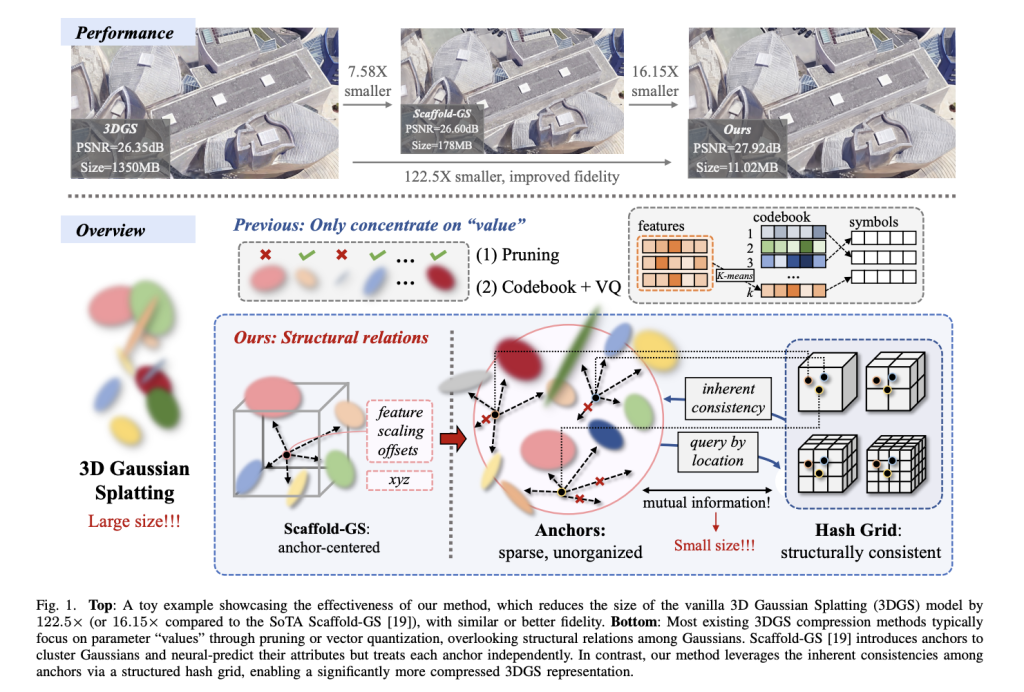

Novel view synthesis has witnessed significant advancements recently, with Neural Radiance Fields (NeRF) pioneering 3D representation techniques through neural rendering. While NeRF introduced innovative methods for reconstructing scenes by accumulating RGB values along sampling rays using multilayer perceptrons (MLPs), it encountered substantial computational challenges. The extensive ray point sampling and large neural network volumes created critical bottlenecks that impacted training and rendering performance. Moreover, the computational complexity of generating photorealistic views from limited input images continued to pose significant technical obstacles, demanding more efficient and computationally lightweight approaches to 3D scene reconstruction and rendering.
Existing research attempts to address novel view synthesis challenges have focused on two main approaches for neural rendering compression. First, Neural Radiance Field (NeRF) compression techniques have evolved through explicit grid-based representations and parameter reduction strategies. These methods include Instant-NGP, TensoRF, K-planes, and DVGO, which attempted to improve rendering efficiency by adopting explicit representations. Compression techniques broadly categorized into value-based and structural-relation-based approaches emerged to tackle computational limitations. Value-based methods such as pruning, codebooks, quantization, and entropy constraints aimed to reduce parameter count and streamline model architecture.
Researchers from Monash University and Shanghai Jiao Tong University have proposed HAC++, an innovative compression framework for 3D Gaussian Splatting (3DGS). The proposed method utilizes the relationships between unorganized anchors and a structured hash grid, utilizing mutual information for context modeling. By capturing intra-anchor contextual relationships and introducing an adaptive quantization module, HAC++ aims to significantly reduce the storage requirements of 3D Gaussian representations while maintaining high-fidelity rendering capabilities. It also represents a significant advancement in addressing the computational and storage challenges inherent in current novel view synthesis techniques.
The HAC++ architecture is built upon the Scaffold-GS framework and comprises three key components: Hash-grid Assisted Context (HAC), Intra-Anchor Context, and Adaptive Offset Masking. The Hash-grid Assisted Context module introduces a structured compact hash grid that can be queried at any anchor location to obtain an interpolated hash feature. The intra-anchor context model addresses internal anchor redundancies, providing auxiliary information to enhance prediction accuracy. The Adaptive Offset Masking module prunes redundant Gaussians and anchors by integrating the masking process directly into rate calculations. The architecture combines these components to achieve comprehensive, and efficient compression of 3D Gaussian Splatting representations.
The experimental results demonstrate HAC++’s remarkable performance in 3D Gaussian Splatting compression. It achieves unprecedented size reductions, outperforming 100 times compared to vanilla 3DGS across multiple datasets while maintaining and improving image fidelity. Compared to the base Scaffold-GS model, HAC++ delivers over 20 times size reduction with enhanced performance metrics. While alternative approaches like SOG and ContextGS introduced context models, HAC++ outperforms them through more complex context modeling and adaptive masking strategies. Moreover, its bitstream contains carefully encoded components, with anchor attributes being entropy-encoded using Arithmetic Encoding, representing the primary storage component.
In this paper, researchers introduced HAC++, a novel approach to address the critical challenge of storage requirements in 3D Gaussian Splatting representations. By exploring the relationship between unorganized, sparse Gaussians and structured hash grids, HAC++ introduces an innovative compression methodology that uses mutual information to achieve state-of-the-art compression performance. Extensive experimental validation highlights the effectiveness of this method, enabling the deployment of 3D Gaussian Splatting in large-scale scene representations. While acknowledging limitations such as increased training time and indirect anchor relationship modeling, the research opens promising avenues for future investigations in computational efficiency and compression techniques for neural rendering technologies.
Check out the Paper and GitHub Page. All credit for this research goes to the researchers of this project. Also, don’t forget to follow us on Twitter and join our Telegram Channel and LinkedIn Group. Don’t Forget to join our 70k+ ML SubReddit.
The post HAC++: Revolutionizing 3D Gaussian Splatting Through Advanced Compression Techniques appeared first on MarkTechPost.
Source: Read MoreÂ




